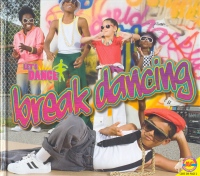| ________________
CM . . .
. Volume XX Number 34. . . .May 2, 2014
excerpt:
Break Dancing is a nonfiction book designed to promote active living, being healthy and learning within a community. The content offers a great overview of breakdancing in a simple manner. It captures the specifics of what to wear and where to dance, as well as sections on warming up, learning moves, staying healthy and dancing facts. Although the table of contents page provides a great list of subheadings, it turns out to be misleading as the titles listed are different from the subheadings found the body of the text. For example, in the table of contents, page 14 is linked to “Learning the Moves”. However, when you turn to page 14, the title is missing and the text reads, “I watch as my teacher does a move. Then I try to do the same move.” Readers will need to create this link on their own. I caution using this book to teach the table of contents text feature as the one provided is a rather ‘messy’ example. Throughout the body of the text, the words and photos are rich and vibrant with colour. They are displayed in such a way that, as you turn the pages, it feels as though you are stepping into a real-life dancing scene or a wall-design created by a graffiti artist. The font is big and bold – white on purple which is clean and crisp to read. This decision creates a beautiful set up to locate word boundaries and to isolate letters which allows for an opportunity to conduct an emergent literacy assessment task during a read. I also love the representation of the diversity of dancers – age, gender, ability, culture! This tells the reader that anyone and everyone can dance and fully express themselves through this medium. The AV² web link provides video extensions to the paper text. The videos are fabulous; however, if you are looking for a recording or a digital copy of the book online, it’s not clear if either exists. The pictures on the website are the same ones found in the book, but the print/captions below them are different. I’m not sure if this was intentional – does the on-line intrigue activate readers’ attention and entice them to dive into the flipping of book pages, or does the ‘whiz bang’ effects and ‘icon clicking’ deter book reading as the visuals present such a beautiful distraction? Nonetheless, the book and the web videos provide information for exploration into the world of breakdancing. Additionally, the last pages of the book are especially informative as the breakdancing facts that are provided are very detailed. For students who love to dance and want to learn a bit more, or for students who want to be inspired to explore breakdancing for the first time, this book may be the nudge they are looking for! Recommended. Carrie Subtelny is a literacy consultant, instructor and tutor in Winnipeg, MB.
To comment
on this title or this review, send mail to cm@umanitoba.ca.
Copyright © the Manitoba Library Association. Reproduction for personal
use is permitted only if this copyright notice is maintained. Any
other reproduction is prohibited without permission.
NEXT REVIEW |
TABLE OF CONTENTS FOR THIS ISSUE
- May 2, 2014.
AUTHORS |
TITLES |
MEDIA REVIEWS |
PROFILES |
BACK ISSUES |
SEARCH |
CMARCHIVE |
HOME |
